tires AUDI S8 2013 Owner's Manual
[x] Cancel search | Manufacturer: AUDI, Model Year: 2013, Model line: S8, Model: AUDI S8 2013Pages: 318, PDF Size: 79.34 MB
Page 259 of 318
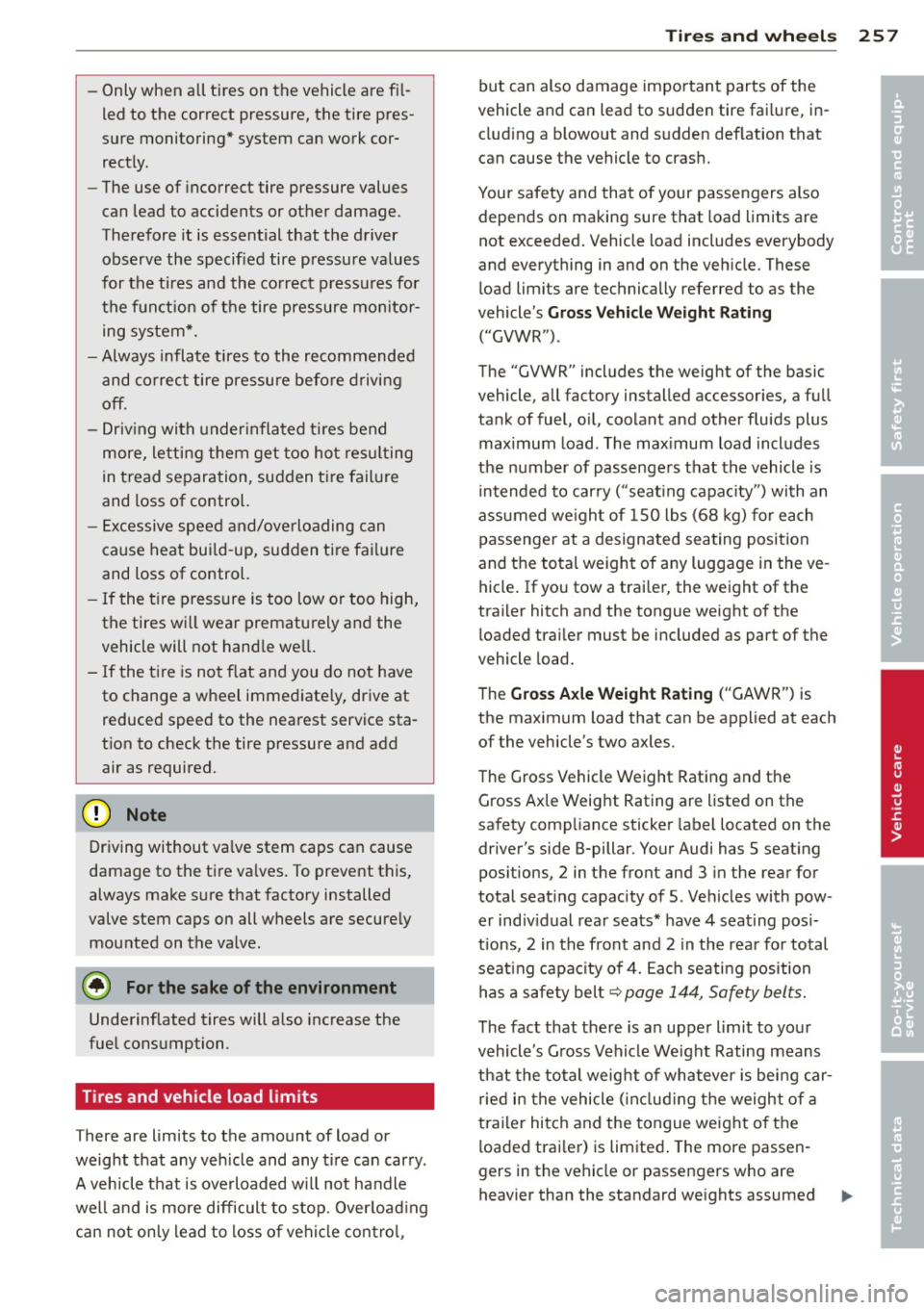
-Only when a ll tires on the vehicle are fi l
led to the correct pressure, the tire pres
sure monitoring* system can work cor rect ly.
- The use of incorrect tire pressure values
can lead to accidents or other damage.
Therefore it is essential that the d river
observe the specif ied tire pressure values
for the tires and the co rrect p ress ures for
the f un ct ion of t he tire pressure mo nitor
ing sy stem*.
- Always inflate ti res to the recommended
and co rrec t tire pressu re befo re dr ivi ng
off.
- Driv ing wi th under infla ted ti res bend
more, letti ng them get too ho t res ulting
in t read separation, sudden t ire fail ure
and loss of control.
- Excessive spee d and/ove rloading can
ca use heat bui ld -up, sudden tire fa il ur e
and loss of control.
- If the t ire pressure is too low or too high,
the tires w ill wea r prematu rely an d the
vehicle will not hand le we ll.
-If the t ire is no t flat and you do no t have
to change a w heel imme diate ly, drive at
reduced speed to the nearest service sta
t ion to check the tire pressure and add
air as required.
(D Note
Driving without va lve stem caps ca n cause
damage to the t ire va lves. To prevent this,
always make s ure that facto ry installed
valve stem caps on all wheels a re secure ly
mounted on the va lve .
@) For the sake of the environment
Underinflated tires will a lso increase the
fue l consumption .
Tires and vehicle load limits
There are limits to the amount of load or
weight that any veh icle and any t ire can carry .
A vehicle that is ove rloaded w ill not ha ndle
well and is more difficult to stop . Overload ing
can no t on ly lead to loss o f vehi cle con tro l,
Tire s an d wheel s 257
but can also damage important parts of the
vehicle and ca n lead to sud den tire fai lure, in
clud ing a b lowout and s udden def lation that
can cause the vehicle to cras h.
Your safety and that of your passengers also depends on making sure that load limits are
not exceeded . Vehicle load includes everybody
and everything in and on the veh icle. These
load lim its are technically referred to as the
vehicle's
Gross Vehicle We ight Rating
("GVWR ") .
The "GVWR" includes the weight of the basic
vehicle, all factory installed accessories, a full
tank of fuel, o il, coo lant and other fluids plus
maximum load . The max imum load includes
the number of passenge rs that th e vehicle is
i n tended to car ry ("seat ing capa city") wi th an
ass umed we igh t of 150 lbs (68 kg) fo r each
passenger at a designated seating posi tion
and t he tota l weight of any luggage i n the ve
hicle . If you tow a trai ler, the weight of the
tra iler hitch and the tongue weight of the
loaded tra iler must be included as part of the
vehicle load.
T he
Gro ss Axle Weight Rating ("GAWR") is
the maximum load that can be applied at each
of the vehicle's two axles.
T he Gross Vehicle Weight Rating and the
G ross Ax le Weig ht Rating are listed on the
safety comp liance sticker label located on the
driver's side B-pillar. Your Audi has 5 seat ing
pos itions, 2 in the front and 3 in the rea r fo r
total seating capacity of 5 . Vehicles with pow
er ind iv idual rea r seats* have 4 seat ing pos i
tions, 2 in the front and 2 in the rea r fo r total
seat ing capac ity o f 4. Each seating position
has a safety belt~
page 144, Safety belts.
The fact that there is a n uppe r limit to you r
vehicle's G ross Vehicle We ight Rating means
t h at the to tal weig ht of whatever is bei ng car
ried in the vehicle ( in cl ud ing t he weight of a
trai ler hitch and the tongue weigh t of t he
loa ded trai le r) is limite d. The more passen
gers in the vehicle or passengers who are
heavier than the standard we ights assumed
•
•
Page 260 of 318
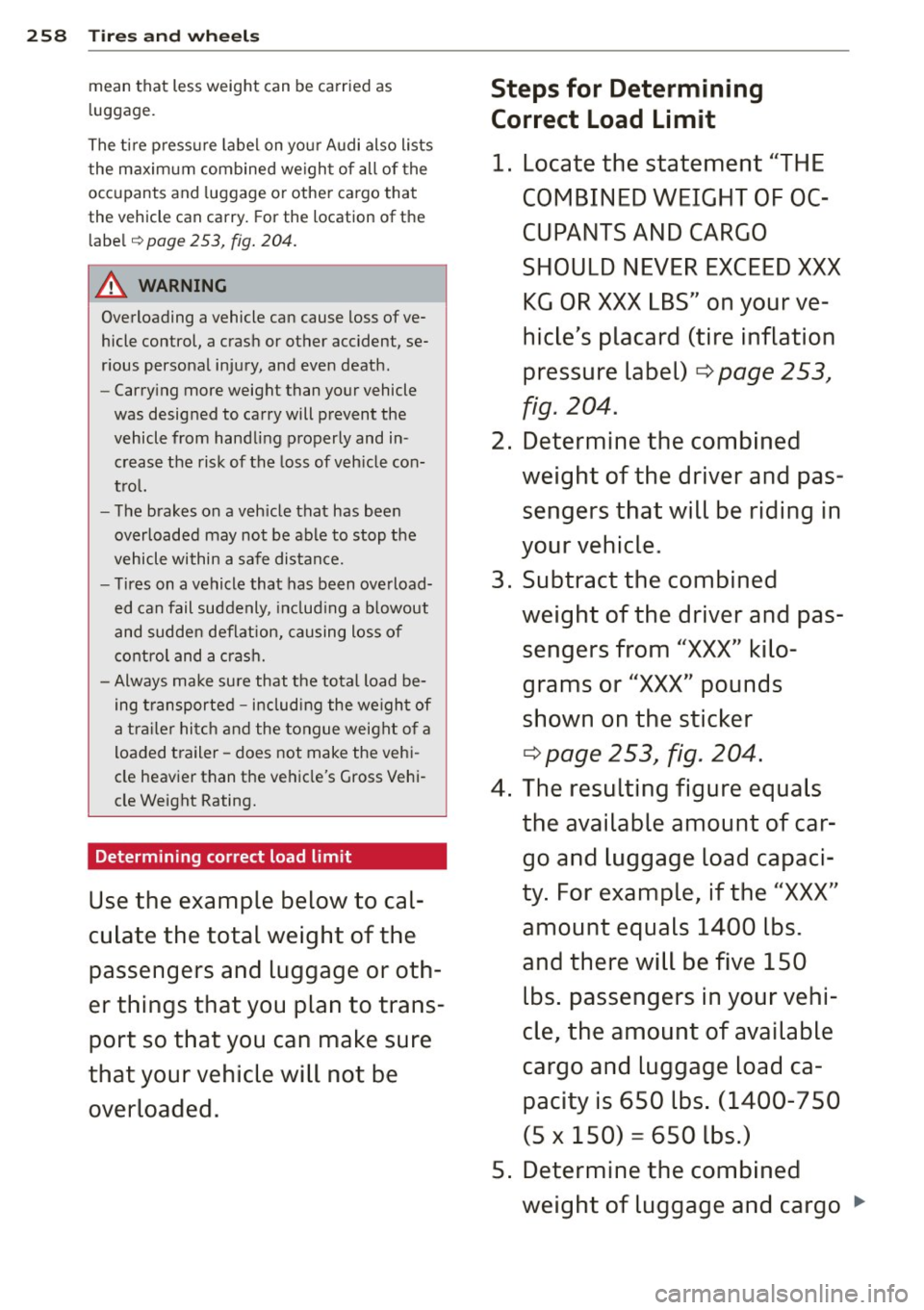
258 Tires and wheels
mean that less weight can be carried as
luggage.
The tire pressure label on your Audi also lists
the maximum combined weight of all of the
occupants and luggage or other cargo that
the vehicle can carry. For the location of the
label ¢
page 253, fig. 204.
.&_ WARNING
Overloading a vehicle can cause loss of ve
hicle control, a crash or other accident, se
rious personal injury, and even death.
- Carrying more weight than your vehicle
was designed to carry will prevent the
vehicle from handling properly and in
crease the risk of the loss of vehicle con
trol.
- The brakes on a vehicle that has been
overloaded may not be able to stop the
vehicle within a safe distance.
- Tires on a vehicle that has been overload
ed can fail suddenly, including a blowout
and sudden deflation, causing loss of
control and a crash.
- Always make sure that the total load be
ing transported -including the weight of
a trailer hitch and the tongue weight of a
loaded trailer -does not make the vehi
cle heavier than the vehicle's Gross Vehi
cle Weight Rating.
Determining correct load limit
Use the example below to cal
culate the total weight of the
passengers and luggage or oth
er things that you plan to trans
port so that you can make sure
that your vehicle will not be overloaded.
Steps for Determining
Correct Load Limit
1. Locate the statement "THE
COMBINED WEIGHT OF QC
CU PANTS AND CARGO
SHOULD NEVER EXCEED XXX KG OR XXX LBS" on your ve
hicle's placard (tire inflation
pressure label)¢
page 253,
fig. 204.
2. Determine the combined
weight of the driver and passengers that will be riding in
your vehicle.
3. Subtract the combined
weight of the driver and pas
sengers from "XXX" kilo
grams or "XXX" pounds
shown on the sticker
¢ page 253, fig. 204.
4. The resulting figure equals the available amount of cargo and luggage load capaci
ty. For example, if the "XXX"
amount equals 1400 lbs.
and there will be five 150 lbs. passengers in your vehi
cle, the amount of available
cargo and luggage load ca
pacity is 650 lbs. (1400-7 50
(5
X 150) = 650 lbs.)
5. Determine the combined weight of luggage and cargo ..,
Page 261 of 318
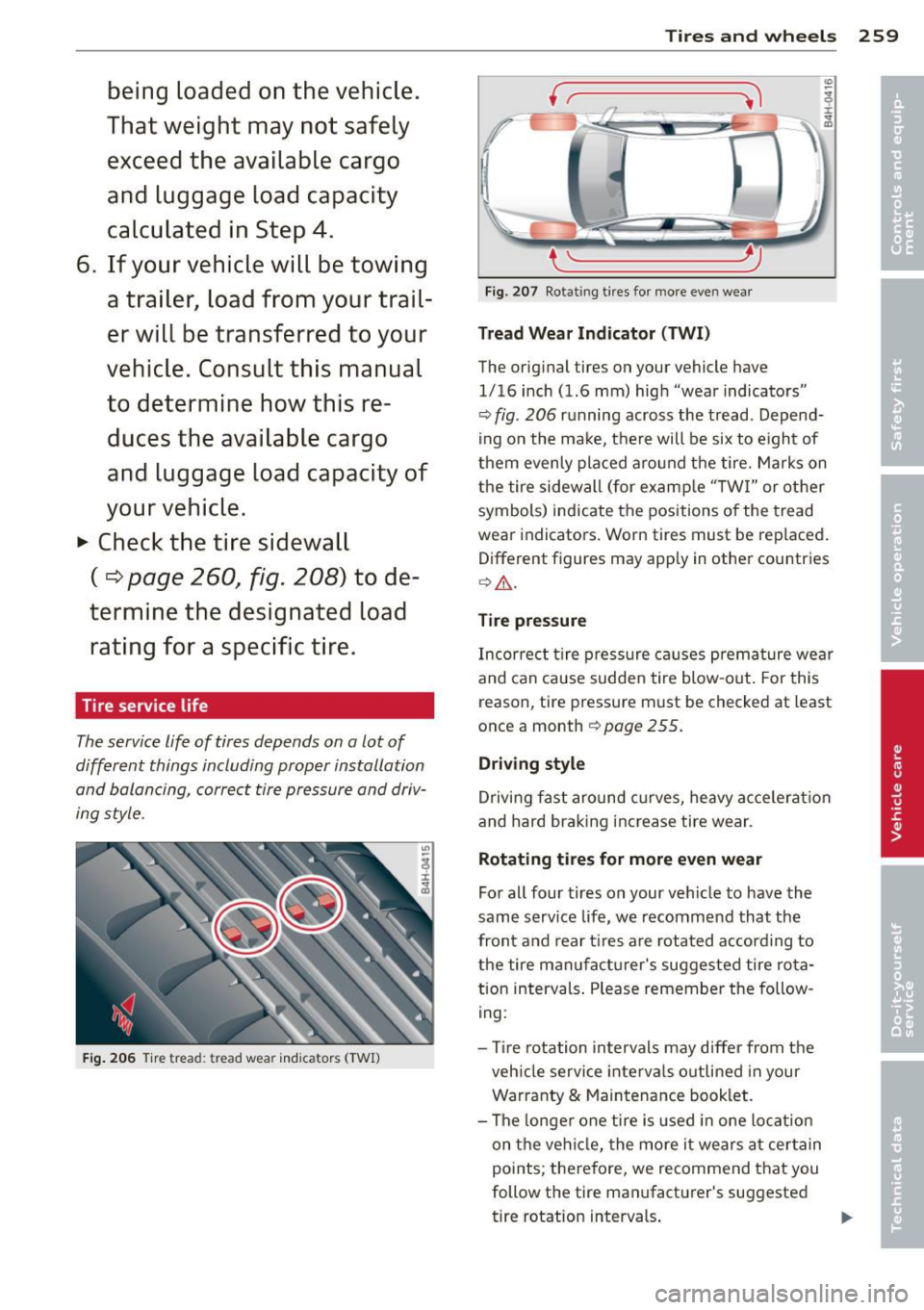
being load ed on th e ve hicle .
Th at w eight ma y no t safely
e xce ed the av ailabl e car go
a nd lug gag e lo ad ca pacity
c alcul ated in St ep 4 .
6. If y our vehicle will be t owing
a tr aile r, lo ad from your trail
er will b e tr an sfe rred to yo ur
ve hicle. Con sult thi s m anu al
t o de te rmine ho w th is re
d uce s th e av ailable car go
a nd lug gage loa d ca pacit y of
y o ur ve hi cle .
_,.. Check the tire sidewall
( c:> pag e 260 ~ fig. 208 ) to de
t e rmin e the d esign ated lo ad
rating f or a sp ecifi c ti re.
Tire service life
The service life of tires depends on a lot of
different things including proper installation
and balancing, correct tire pressure and driv
ing style.
F ig . 2 06 Tire tread : tread wear ind icators (TWil
Tires and wheels 259
{ '"------
F ig. 207 Rotat ing tires for more eve n wea r
Tread Wear Indicator (TWI)
The orig inal tires on your vehicle have
1/16 inch (1.6 mm) high "wear indicators"
9 fig. 206 r u nning across the tread. Depend
ing on the ma ke, there will be six to e ight of
them evenly pla ced aro und the tire. Marks on
the tire sidewall (for e xamp le "T W I" or other
symbols) indicate the positions of the tread
wear indicators . Worn tires must be replaced .
D ifferent figures may apply in othe r countries
9 & .
Tire pres sure
Incor rect t ire press ure ca uses premature wear
and can cause sudde n tire blow-out . For this
reason, tire pressure must be checked at least
once a month
9 page 255.
Driving style
Driving fast around curves, heavy a ccele rat io n
and har d brak ing inc rease tire wear.
Rotating tires for more even w ear
For all four tires on your vehicle to have the
s a me service life, we recommend that the
front and rear t ires are rota ted accord ing to
the tire m anufact urer's suggested tire ro ta
tion intervals . Please remember the follow
ing:
- Tire rotation in tervals may d iffer from the
veh icle service inte rva ls o utlined in your
Warranty & Main tenance booklet.
- The longer o ne tire i s used in one lo cation
on the vehi cle, the more it wears at cer tain
points ; therefore, we recommend t hat you
follow the tire manufact urer's suggested
tire rotation intervals .
Page 262 of 318

260 Tires and wheels
-Vehicles with front-wheel drive experience
more tread wear on the front wheels com
pared to all-wheel drive (quattro ®).
- Please rotate tires as shown
¢fig. 207.
- Extra care must be taken when rotating di-
rection-specific tires
¢ page 2 78.
Wheel balancing
The wheels on new vehicles are balanced .
H owever, various situations during everyday
driving can cause them to become unbal
anced , resu lting in vibrations you can usually
feel through the steering wheel.
Unba lanced wheels must be rebalanced to
avoid excessive wea r on steering , suspens ion
and tires . A wheel must also be rebalanced
when a new tire is installed.
Incorrect wheel alignment
Incorrect whee l alignment can cause exces
sive tire wear, impair ing the safety of the vehi
cle .
If tires show excess ive wear, have the
wheel alignment checked by an authorized
Audi dealer or qualified workshop.
All Wheel Drive
Vehicles with quattro® must always have ti res
of the same size, construction and tread type.
F or details see
¢page 203.
A WARNING
Sudden tire failure can lead to loss of con
trol, a crash and serious personal injury!
- Never drive a vehicle when the tread on
any tire is worn down to the wear indica
tors.
- Worn tires are a safety hazard, they do
not grip well on wet roads and increase
your risk of "hydrop laning" and loss of
control.
- Always keep chemicals that can cause
tire damage, such as grease, oil, gasoline
and brake fluid away from tires.
- Tires age even if they are not be ing used
and can fail suddenly, especially at high
speeds. Tires that are more than 6 years old can only be used in an emergency and then with specia
l care and at lower
speeds.
- Never mount used tires on your vehicle if
you are not sure of their "previous histo
ry." Old used tires may have been dam
aged even though the damage cannot be
seen that can lead to sudden tire failure
and loss of vehicle control.
New tires and replacing tires and wheels
New tires and wheels have to be broken in.
Fig. 208 Tir e spec ificatio n codes on the s idewall of a
tire
No.
©
®
®
0
®
®
@
Description
Passenger car tire (where applicable)
Nominal width of tire in mill imeters
Ratio of height to width (aspect ratio)
Rad ial
Rim diameter code
Load index and speed rating
U.S. DOT tire identification number
Aud i Original tire
Sever snow conditions
Tire ply composition and materials
used
Maximum load rating
Page 263 of 318
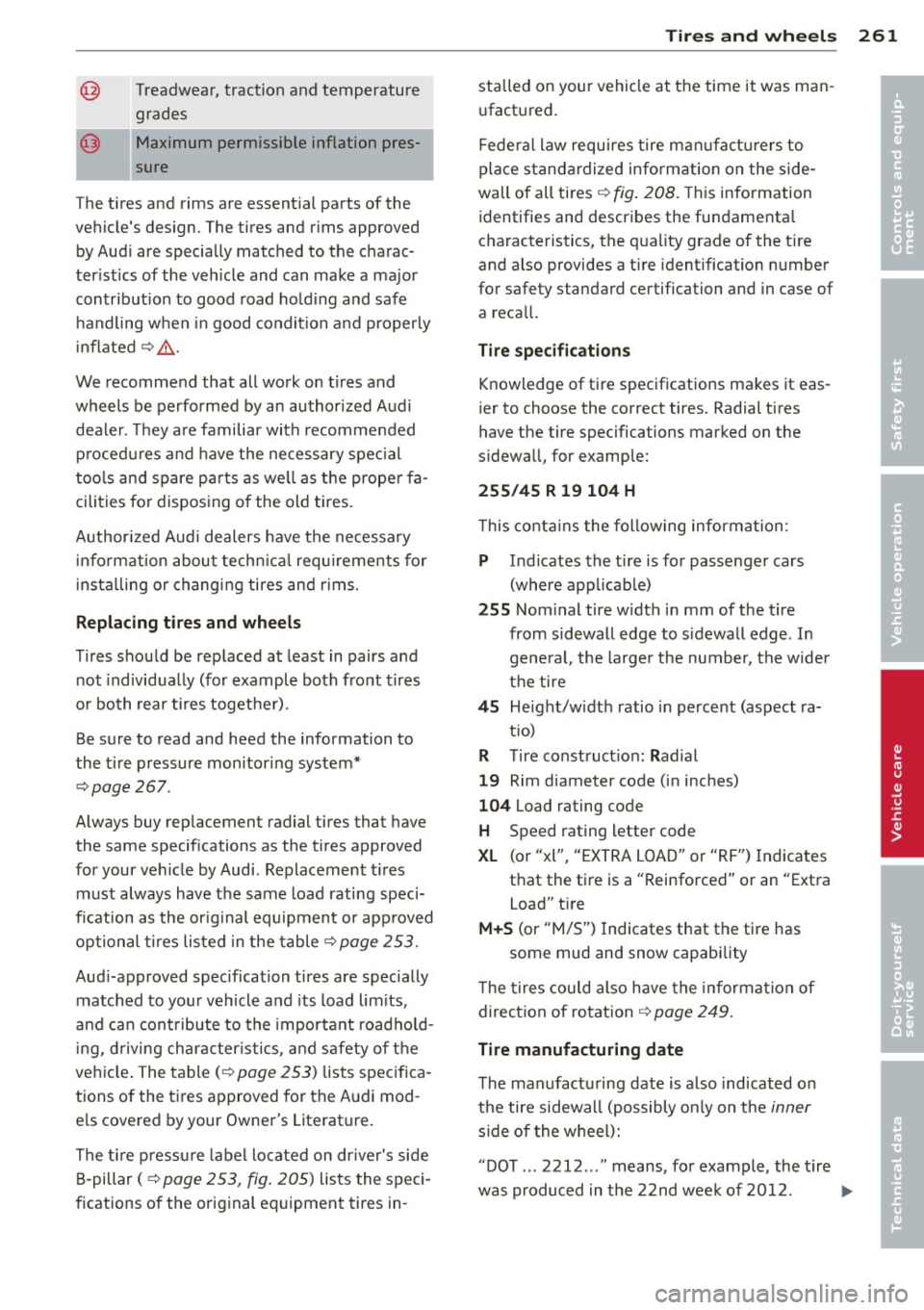
@ Treadwear, traction and temperature grades
@ ·· Maximum permissible inflation pres
. . sure
The tires and rims are essential parts of the
vehicle's design. The tires and r ims approved
by Aud i are specially matched to the charac
ter istics of the vehicle and can make a major
contribution to good road ho ld ing and safe
handling when in good condition and properly
inflated ¢
&.
We recommend that all work on tires and
wheels be performed by an authorized Audi
dea ler. They a re familiar with recommended
procedu res and have the necessary spec ial
too ls and spare par ts as we ll as the prope r fa
cilities for disposing of the old tires.
Author ized Audi dealers have the necessary
informat ion about techn ica l requ irements for
installing or changing tires and r ims.
R eplacing t ires and whe els
Tires should be replaced at least in pairs and
not individua lly (for example both front tires
or both rear tires togethe r) .
Be sure to read and heed the information to
the t ire pressure monitoring system*
¢page 267 .
Always buy replacement radial tires that have
the same specifications as the tires approved
for your vehicle by Audi . Replacement t ires
must always have the same load rating speci
fication as the or iginal equipment or app roved
optional ti res listed in the table ¢
page 253.
Audi-approved specification tires are specially
matched to you r vehicle and its load lim its,
and can cont ribute to the important road ho ld
i ng, d riving character istics, and safety of the
vehicle . The table(¢
page 253) lists spec ifica
tions of the tires approved for the A udi mod
e ls covered by your Owner's Literature.
The ti re p ress ure label located on dr iver's side
B-pillar
(¢page 253, fig. 205) lists the speci
fications of the original equipment tires in-
Tire s an d wheel s 261
stalled on your vehicle at the time it was man
u factured.
Federa l law requ ires tire man ufactu rers to
place standardized info rmation on the side
wall of all tires¢
fig. 208. This information
identifies and descr ibes the fundamenta l
characteristics, the q uality grade of the t ire
and also provides a t ire identification number
for safety standard certification and in case of
a reca ll.
Tir e s pecific ation s
Knowledge of tire specifications makes it eas
ier to choose the correct tires . Radial tires
have the tire specifications marked on the
s idewall, for example:
2 55 /45 R 19 104 H
T his conta ins the following information:
P Indicates the tire is for passenger cars
(where app licab le)
2 55 Nom inal tire w idth in mm of the t ire
from sidewall edge to sidewall edge . In
general, the larger the number, the wider
the tire
45 Height/w idth ratio in perce nt (aspect ra-
t io)
R Tire construct ion : Radial
19 Rim diameter code (in inches)
104 Load rating code
H Speed rating letter code
XL (or "xl", "EXTRA LOAD" or "RF") Indicates
that the tire is a "Reinforced" or an "Extra Load" tire
M+S (or "M/S") Indicates that the tire has
some mud and snow capability
T he tires could also have the informa tion of
direction of rotat ion ¢
page 249.
Tire manufacturing date
The manufactu ring date is also indicated on
the tire sidewall (possibly on ly on the
inner
s ide of the whee l):
"DOT ... 2212 ... " means, for example, the t ire
was produced in the 22nd week of 2012 . ..,.
•
•
Page 264 of 318
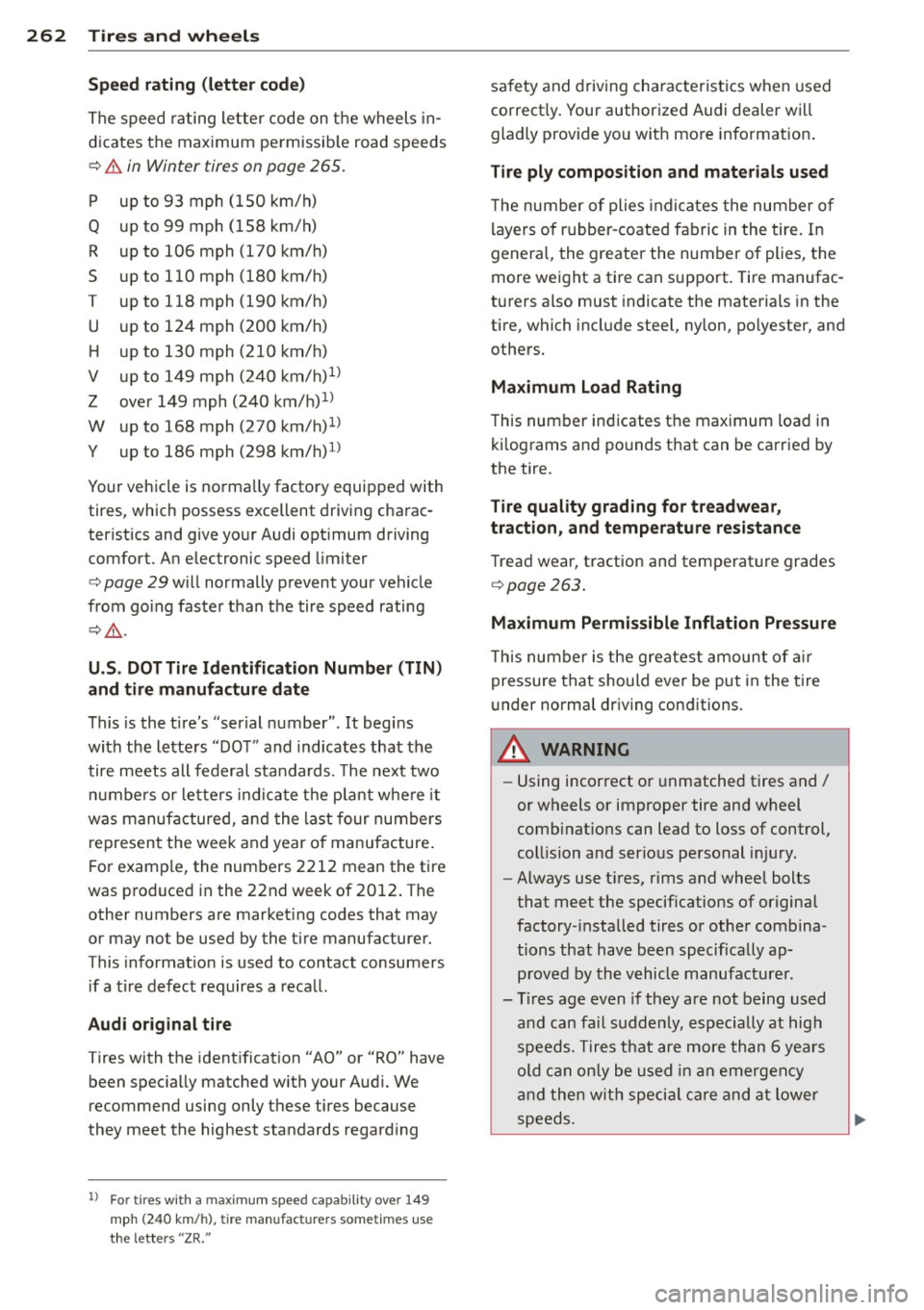
262 Tire s and wheels
Speed rating (letter code)
The speed rating letter code on the wheels in
dicates the maximum pe rmissib le road speeds
¢ & in Winter tires on page 265 .
p up to 93 mph (150 km/h)
Q up to 99 mph (158 km/h)
R up to 106 mph (170 km/h)
s up to 110 mph (180 km/h)
T up to 118 mph (190 km/h)
u up to 124 mph (200 km/h)
H up to 130 mph (210 km/h)
V up to 149 mph (240 km/h)1l
z over 149 mph (240 km/h)1l
w up to 168 mph (270 km/h)1l
y up to 186 mph (298 km/h)1l
Your vehicle is normally factory equipped with
tires, which possess excellent driving charac
teristics and give your Audi optimum driving
comfort. An electronic speed limiter
<=> page 29 will normally prevent your vehicle
from go ing faster than the tire speed rating
<=> & .
U.S . DOT Tire Identification Numbe r (TIN)
and tire manufacture date
This is the t ire's "serial number". It begins
with the letters "DOT" and indicates that the
tire meets all federal standards. The next two
numbers or letters indicate the plant whe re it
was manufactured, and the last four numbers
represent the week and year of manufacture.
F or example, the numbers 2212 mean the tire
was produced in the 22nd week of 20 12. The
other numbers are marketing codes that may
or may not be used by the t ire manufacturer.
This information is used to contact consumers
if a tire defect requires a recall.
Audi original tire
Tires with the identification "AO" or "RO" have
been specially matched with your Audi. We
recommend using only these tires because
they meet the highest standards regarding
ll For tires wit h a max imum speed capab ility over 149
mph (240 km/h), tire man ufactur ers sometimes use
the letters "ZR."
safety and driving characterist ics when used
correct ly . Your authorized Audi dealer will
gladly provide you w ith more information.
Tire ply composition and materials used
The number of plies indicates the number of
layers of rubber-coated fabric in the tire. In
genera l, the greater the number of plies, the
more weight a tire can support. Tire manufac
turers also must indicate the materials in the
tire, which include steel, nylon, polyester, and
others.
Maximum Load Rating
This number indicates the maximum load in
kilograms and pounds that can be carried by
the tire.
Tire quality grading for treadwear,
traction , and temperature resistance
Tread wear, traction and temperat ure grades
<=> page 2 63.
Maximum Permissible Inflation Pressure
Th is number is the greatest amount of air
pressure that should ever be put in the tire
under normal driving conditions.
A WARNING
-Using incorrect or unmatched tires and/
or wheels or improper tire and wheel
comb inat ions can lead to loss of control,
coll is ion and serious personal injury.
- Always use tires, rims and wheel bolts
that meet the specif ications of original
factory- installed tires or other combina
tions that have been specifically ap
proved by the vehicle manufacturer.
- T ires age even if they are not being used
and can fail suddenly, especially at high
speeds. Tires that are more than 6 years
old can only be used in an emergency
and then with specia l care and at lower
speeds.
Page 265 of 318
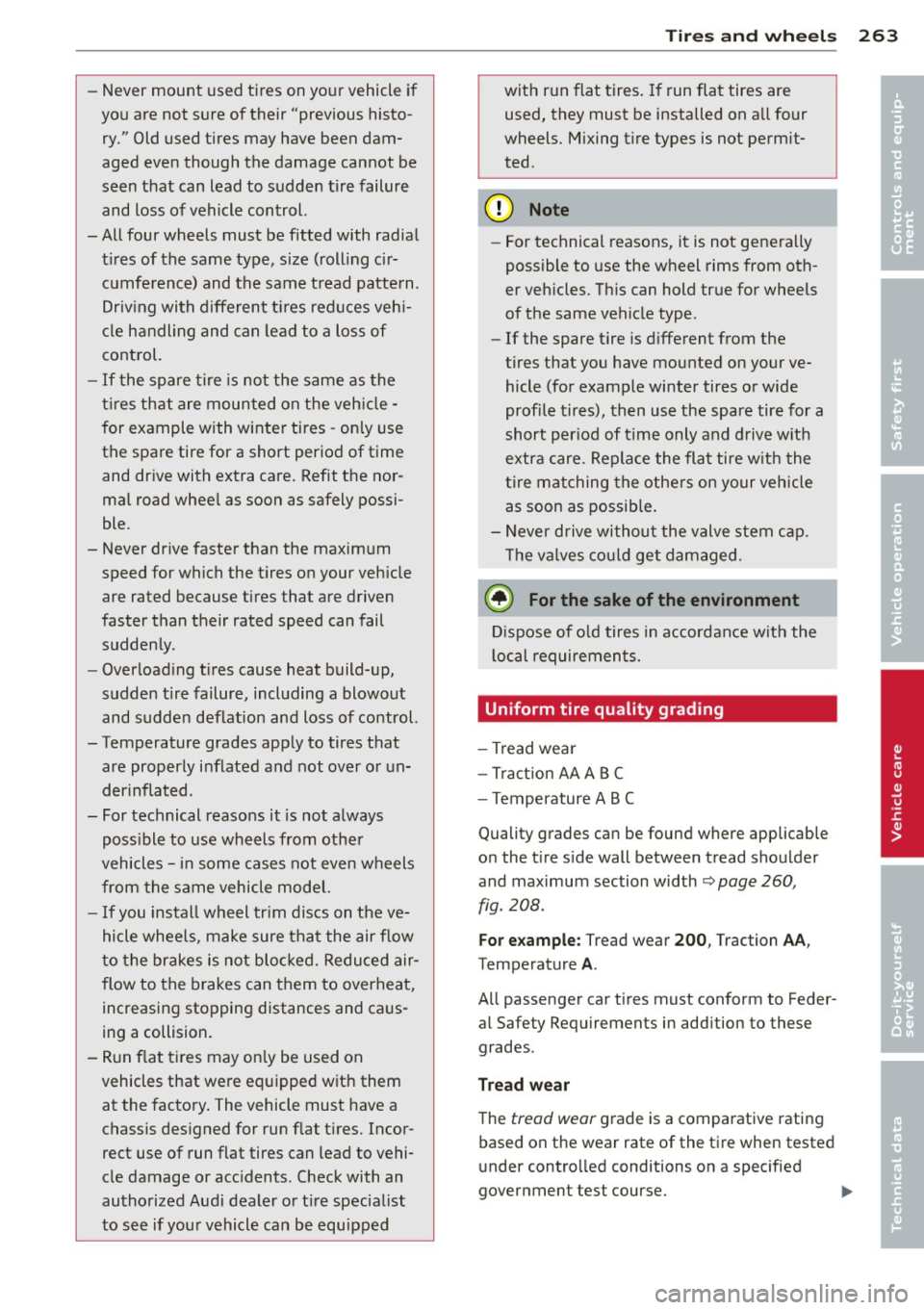
-Never mount used tires on your vehicle if
you are not sure of their "previous histo
ry." Old used tires may have been dam
aged even though the damage cannot be
seen that can lead to sudden tire failure
and loss of vehicle control.
- All four wheels must be fitted with radial
tires of the same type, size (rolling cir
cumference) and the same tread pattern.
Driving with different tires reduces vehi
cle handling and can lead to a loss of
control.
- If the spare tire is not the same as the
tires that are mounted on the vehicle -
for example with winter tires - only use
the spare tire for a short period of time and drive with extra care. Refit the nor
mal road wheel as soon as safely possi
ble.
- Never drive faster than the maximum
speed for which the tires on your vehicle
are rated because tires that are driven
faster than their rated speed can fail
suddenly.
- Overloading tires cause heat build-up,
sudden tire failure, including a blowout
and sudden deflation and loss of control.
- Temperature grades apply to tires that
are properly inflated and not over or un
derinflated .
- For technical reasons it is not always
possible to use wheels from other
vehicles - in some cases not even wheels
from the same vehicle model.
- If you install wheel trim discs on the ve
hicle wheels, make sure that the air flow
to the brakes is not blocked. Reduced air
flow to the brakes can them to overheat,
increasing stopping distances and caus
ing a collision.
- Run flat tires may only be used on
vehicles that were equipped with them
at the factory. The vehicle must have a
chassis designed for run flat tires. Incor
rect use of run flat tires can lead to vehi
cle damage or accidents. Check with an
authorized Audi dealer or tire specialist
to see if your vehicle can be equipped
Tires and wheels 263
with run flat tires. If run flat tires are
used, they must be installed on all four
wheels. Mixing tire types is not permit
ted.
@ Note
- For technical reasons, it is not generally
possible to use the wheel rims from oth
er vehicles. This can hold true for wheels
of the same vehicle type.
- If the spare tire is different from the
tires that you have mounted on your ve
hicle (for example winter tires or wide
profile tires), then use the spare tire for a
short period of time only and drive with
extra care. Replace the flat tire with the
tire matching the others on your vehicle
as soon as possible.
- Never drive without the valve stem cap .
The valves could get damaged.
(® For the sake of the environment
Dispose of old tires in accordance with the
local requirements.
Uniform tire quality grading
-Tread wear
- Traction AA A B C
- Temperature ABC
Quality grades can be found where applicable
on the tire side wall between tread shoulder
and maximum section width
~ page 260,
fig. 208 .
For example: Tread wear 200, Traction AA,
Temperature A.
All passenger car tires must conform to Feder
al Safety Requirements in addition to these
grades .
Tread wear
The tread wear grade is a comparative rating
based on the wear rate of the tire when tested
unde r contro lled conditions on a specified
government test course. •
•
Page 266 of 318
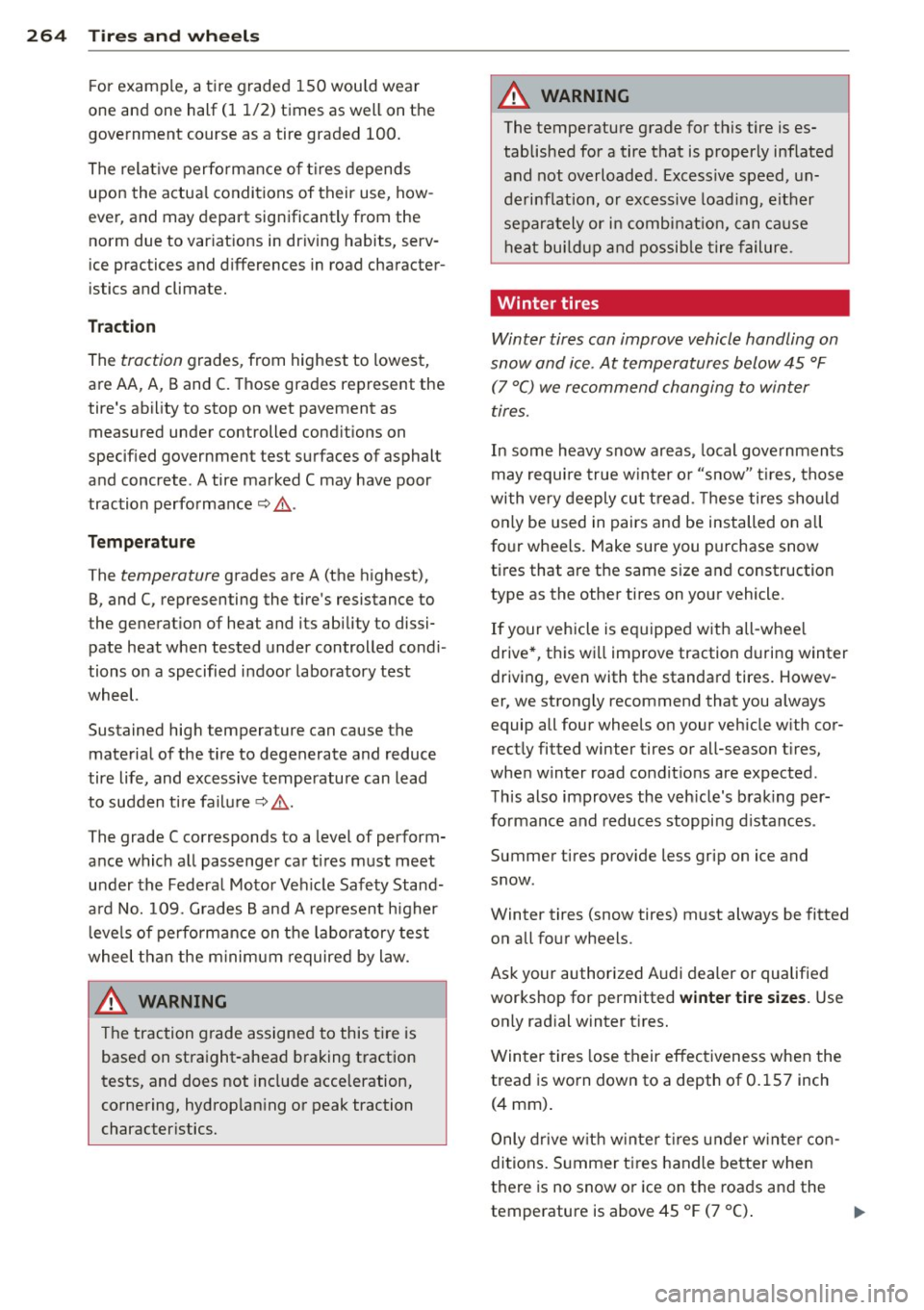
264 Tire s and wheel s
For example, a tire graded 150 wou ld wear
one and one half (1 1/2) times as well on the
government course as a tire graded
100.
The relat ive perfo rmance of t ires depends
upon the actua l conditions of their use, how
ever, and may depart significantly from the norm due to var iat ions in dr iving habits, serv
ice practices and differences in road character
istics and climate.
Traction
The traction grades, from highest to lowest,
are AA, A, Band
C. Those grades represent the
tire's ability to stop on wet pavement as
measured under controlled cond it ions on
specif ied government test surfaces of asphalt
and concrete . A tire marked
C may have poor
traction performance
q ,& .
Temp eratu re
The temperature grades are A (the h ighest),
B, and
C, representing the t ire 's resistance to
the generat ion of heat and its ability to dissi
pate heat when tested under controlled cond i
tions on a specified i ndoor laboratory test
wheel.
Sustained hig h temperature can cause the
materia l of the tire to degenerate and reduce
tire life, and excessive tempe rature can lead
to sudden ti re failu re
q ,& .
The grade C corresponds to a level of perform
ance which a ll passenger car tires must meet
u nder the Federa l Moto r Ve hicle Safety Stand
a rd No.
1 09. G rades Band A represent higher
l eve ls of pe rformance on the labo ratory test
wheel than the m inimum required by law.
A WARNING
T he traction grade assigned to this t ire is
based on straight-ahead b raking traction
tests, and does not incl ude acceleration,
cornering, hydrop lan ing or peak traction
character istics.
A WARNING
The temperature grade for this tire is es
tablished for a tire that is properly inflated
and not overloaded. Excess ive speed, un
derinflation, or excessive load ing, either
separa tely or in comb inat ion, can ca u se
h eat bui ld up a nd possib le tire failure.
-
Winter tires
Winter tires can improve vehicle handling on
snow and ice . At temperatures below 45 °F
(7 °C) we recommend changing to winter
tires.
In some heavy snow areas , local gove rnments
may requi re true w in te r or "snow" tires, those
wi th very deeply cut t read . T hese tires sho uld
o n ly be used in pairs and be installed on a ll
fo ur whee ls. Make sure you purchase snow
ti res that are the same size and construction
type as the other tires on your vehicle.
If your vehicle is e quipped w it h all-whee l
drive*, this wi ll improve traction during winter
driving, even with the standa rd tires . Howev
er, we strongly recommend that you always
equip all four wheels o n your veh icle w ith cor
rect ly fitted winter tires or all-season t ires,
when winter road condit ions are expected .
Th is also improves the veh icle's brak ing per
fo rmance and reduces stoppi ng d ista nces .
Summer tires provide less grip on ice and
snow .
Winter tires (snow tires) must always be fitted on all four wheels .
Ask your authorized A udi dealer or qualified
workshop for permitted
winter ti re size s. Use
on ly rad ial winter tires.
Win ter tires lose their effec tiveness when the
tread is worn down to a depth of
0. 157 inch
(4 mm) .
Only drive w ith w in te r tir es under w inte r con
di tions. S umme r tires handle bette r when
there is no snow or ice on the roads and the
temperature is above 45
°F (7 °() .
Page 267 of 318

If yo u have a flat tire, see notes on spa re
wheel
¢ page 260 .
P lease always remember th at w inte r ti res may
have a lower speed rating than the t ires origi
na lly installed on your vehicle at the time it
was manufactured. Please see ¢
page 262,
Speed rating (letter code) for a list ing of the
speed rat ing letter codes and the m aximum
speed at which the tires can be driven .
The speed rating letter code( ¢
page 252) is
on the s ide wall of the tire ¢
page 260.
A WARNING
Winter tires have maximum speed limits
that may be lower than your vehicle's max
imum speed . Always know the maximum
speed before driving off. Never drive faster
than the speed permitted for your specific
w inter t ires. This will cause damage to the
t ires leading to an acc ident and serious
personal in jury to you and yo ur passen
gers .
& WARNING
Driving faster than the maximum speed
for which the winter tires on your vehicle
were designed can cause tire fai lure in
cluding a blowout and sudden deflat ion,
loss of control, crashes and serious per
sonal injuries . Have worn or damaged tires
rep laced immed iate ly .
- Winter tires have max imum speed rat ing
that may be lower than your veh icle's
maximum speed .
- Never drive faster than the speed for wh ich the winter or other tires installed
on your vehicle are rated.
A WARNING
Always adjust your d rivi ng to the road and
t raffic conditions. Neve r let t he good ac
celeration of the winte r tires and all-whee l
drive tempt you into taking extra r is ks. A l
ways remember:
Tire s an d wheel s 265
-W hen braking, an a ll-wheel drive vehicle
handles in the same way as a front drive
veh icle.
- Drive carefully and reduce your speed on
icy and slippery roads, even w inter t ires
cannot help under black ice conditions.
@ For the sake of the environment
Use summer tires when weather condi
tions permit. They are quieter, do not wear
as quickly and reduce fuel consumpt ion.
Snow chains
Snow cha ins may be fitted only to the front
whee ls, and o nly to certain tire sizes . Ask your
authorized Aud i dea le r on which tire sizes
snow c hains can be used.
If you a re go ing to u se snow chains, then you
must install them on the front whee ls at
least.
The snow chains mus t have low-profile links
and must not be th icker than 0 .4 inch
(10,5 mm) , includ ing t he lock.
Remove wheel center covers and trim discs
before putt ing snow cha ins on your vehicle
¢ (D . For safety reasons cover caps must then
be fitted over the wheel bol ts . These a re ava il
able from autho rized Aud i deale rs .
A WARNING
Usi ng the wrong snow chai ns for your vehi
cle o r insta lling them incorrect ly can in
crease the r isk of loss of cont ro l leading to
serious pe rsonal injury.
- Snow chains are available in different
sizes . Always make sure to follow the in
structions provided by the snow chain manufacturer .
- When drivi ng with snow chains never
drive faster than the speed permitted for
your specif ic snow chains.
- Always observe local regulations .
•
•
Page 268 of 318

26 6 T ire s and whee ls
- Remove snow chains before driving on
roads not covered with snow to avoid
damaging t ires and wearing the snow
chains down unnecessarily.
- Snow chains, which come into d irect con
tact with the wheel rim, can scratch or
damage it. Therefore, make sure that the
snow chains are suitably covered . Check
the position of the snow chains after
driving a few yards and correct if neces
sary. Follow the instructions from the
snow chain manufacturer when doing so.
- If the Adaptive Air Suspension should
malfunction, do not mo unt or use snow
cha ins beca use the veh icle will be ex
tremely low. If you do drive with snow
chains on while the vehicle is at this lev
el, the snow chains might severely dam
age the wheelhouse and other parts of
the veh icle.
Where snow chains are mandatory oncer
tain roads, this normally also applies to
veh icles with All Wheel Drive.
Wheel bolts
Wheel bolts must always be tightened to the
correct torque.
The design of whee l bolts is matched to the
factory installed rims. If different rims are fit
ted, the correct wheel bolts with the r ight
length and correctly shaped bolt heads must
be used. This ensures that wheels are fitted
securely and that the brake system functions
cor rectly .
In certain circumstances, you may not use
wheel bolts from a different vehicle - even if it is the same model
~ page 298.
A WARNING
Imprope rly tightened o r maintained wheel
bolts can be come loose caus ing loss of control, a col
lision and serio us personal in
jury.
- Always keep the wheel bo lts and the
threads in the whee l hubs clean so the
wheel bo lts can turn easily and be prop
erly tightened.
- Never grease or oil the wheel bolts and
the threads in the wheel hubs. They can become loose while driv ing if greased or
oiled, even if t ightened to the specified
torque.
- Only use wheel bolts that belong to the rim being installed .
- Never use different wheels bolts on your
veh icle.
- Always ma intain the correct tightening
torque for the whee l bolts to reduce the
risk of a wheel loss. If the tightening tor
que of the wheel bolts is too low, they
can loosen and come out when the vehi
cle is mov ing. If the tig htening torq ue is
too high, the wheel bolts and threads
can be damaged and the whee l can be
come loose .
(D Note
The specified torque for the whee l bolts is
90
ft l b (120 Nm) with a tolerance of± 7,4
ft lb(± 10 Nm) . Torque whee l bolts diago
nally . After changing a whee l, the torque
must be checked as soon as possible with a
torque wrench -preferably by an author
i zed Audi dealer or qualif ied workshop.
Low aspect ratio tires
Your Audi is factory-equ ipped w ith low aspect
ratio tires . These tires have been thoroughly
tested and been se lected specifically fo r your
model for their superb perfo rman ce, road fee l
and hand ling under a variety o f driving condi
tions. Ask your authorized A udi dealer for
more details .
T he low aspect ratio of these tires is ind icated
by a numera l of
55 o r less in the tire's s ize
designation. The numeral rep resents the ratio
of the tire's sidewa ll height in relation to its
ll-